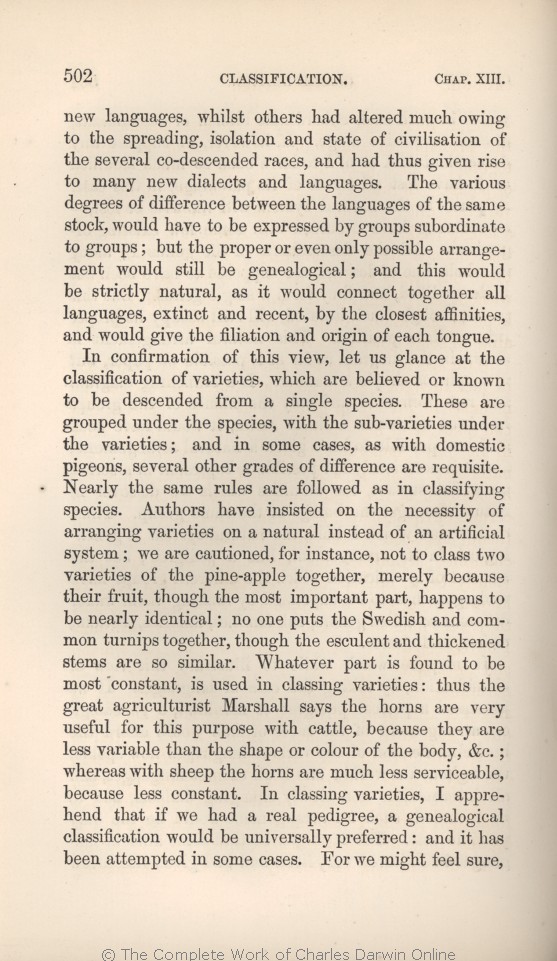new languages, whilst others
had altered much owing | had altered much owing 1869 1872 |
| (owing 1859 1860 1861 1866 |
| spreading, 1869 1872 | | spreading 1859 1860 1861 1866 |
| ..... 1869 1872 | | and subsequent 1859 1860 1861 1866 |
| isolation 1859 1860 1861 1866 1869 | | isolation, 1872 |
| state 1869 1872 | | states 1859 1860 1861 1866 |
| ..... 1869 1872 | | races, 1859 1860 1861 1866 |
| co-descended 1869 1872 | | descended 1859 1860 1861 1866 |
| races, 1869 1872 |
| from a common race) had altered much, 1859 1860 1861 |
| from a common stock) had altered much, 1866 |
| thus given 1869 1872 | | given 1859 1860 1861 1866 |
| dialects 1869 1872 | | languages 1859 1860 1861 1866 |
| languages. 1869 1872 | | dialects. 1859 1860 1861 1866 |
| between 1869 1872 | | in 1859 1860 1861 1866 |
| of 1869 1872 | | from 1859 1860 1861 1866 |
| only 1859 1860 1861 1866 1869 | | the only 1872 |
| recent, 1869 1872 | | modern, 1859 1860 1861 1866 |
|
In confirmation of this view, let us glance at the classification of varieties, which are
believed | believed 1859 1860 1861 1866 1869 | | known 1872 |
| known 1859 1860 1861 1866 1869 | | believed 1872 |
| be 1869 1872 | | have 1859 1860 1861 1866 |
| a single 1869 1872 | | one 1859 1860 1861 1866 |
| the species, with the 1869 1872 |
| species, with 1859 1860 1861 1866 |
| the varieties; and in some cases, as with domestic pigeons, 1869 |
| varieties; and with our domestic productions, 1859 1860 1861 1866 |
| the varieties; and in some cases, as with the domestic pigeon, with 1872 |
| difference 1859 1860 1861 1866 1869 | | difference. 1872 |
| are 1859 1860 1861 1866 1869 | are 1872 |
| requisite. 1869 | | requisite, 1859 1860 1861 1866 | requisite. 1872 |
| ..... 1869 | | as 1859 1860 1861 1866 | OMIT 1872 |
| ..... 1869 | | we 1859 1860 1861 1866 | OMIT 1872 |
| ..... 1869 | | have 1859 1860 1861 1866 | OMIT 1872 |
| ..... 1869 | | seen 1859 1860 1861 1866 | OMIT 1872 |
| ..... 1869 | | with 1859 1860 1861 1866 | OMIT 1872 |
| ..... 1869 | | pigeons. 1859 1860 1861 1866 | OMIT 1872 |
| 1 blocks not present in 1869 1872; present in 1859 1860 1861 1866 | | The origin of the existence of groups subordinate to groups,
is the same with varieties as with species, namely, closeness of descent with various degrees of modification.
|
| as in classifying 1869 1872 |
| in classifying varieties, as with 1859 1860 1861 1866 |
| arranging 1869 1872 | | classing 1859 1860 1861 1866 |
| Swedish 1861 1866 1869 1872 | | swedish 1859 1860 |
| turnips 1859 1860 1861 1866 1869 | | turnip 1872 |
| varieties, 1859 1860 1861 1866 1869 | | varieties; 1872 |
| that if 1866 1869 1872 | | if 1859 1860 1861 |
| preferred: 1869 | | preferred; 1859 1860 1861 1866 1872 |
| in 1869 1872 | | by 1859 1860 1861 1866 |
| cases. 1869 1872 | | authors. 1859 1860 1861 1866 |
|









